


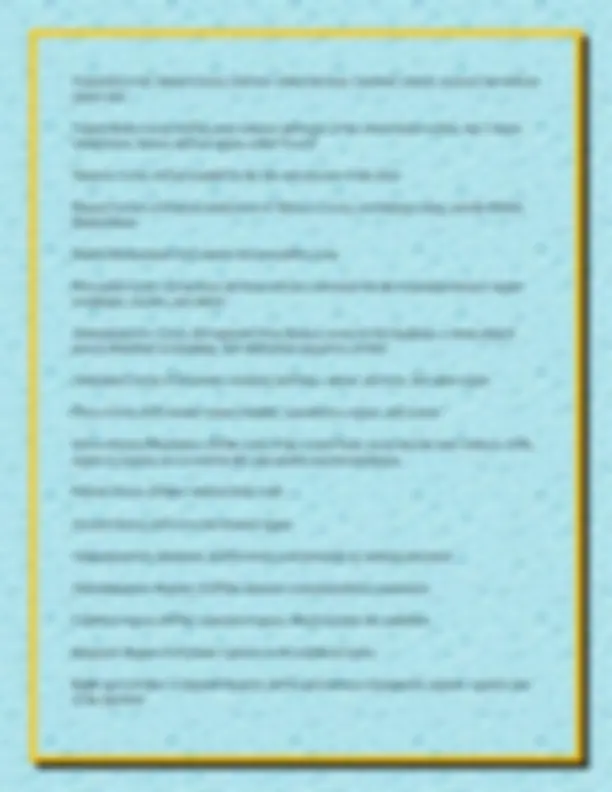
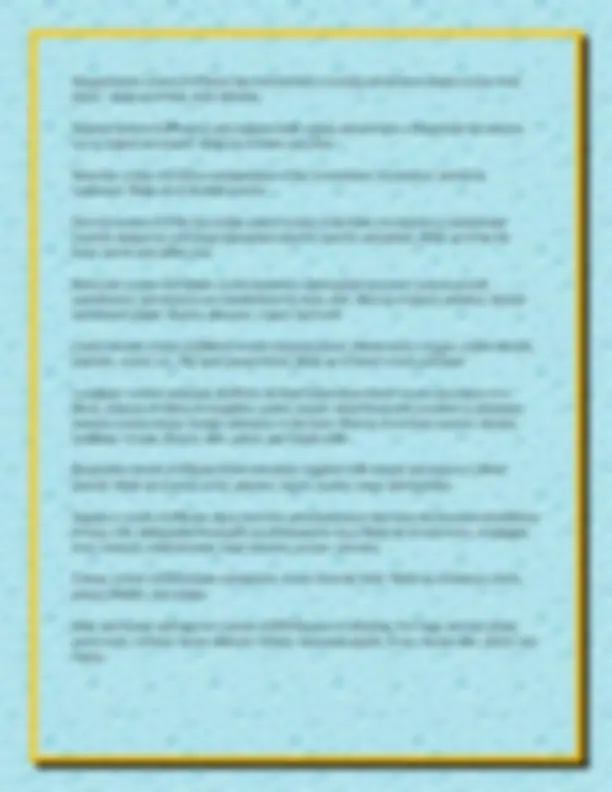
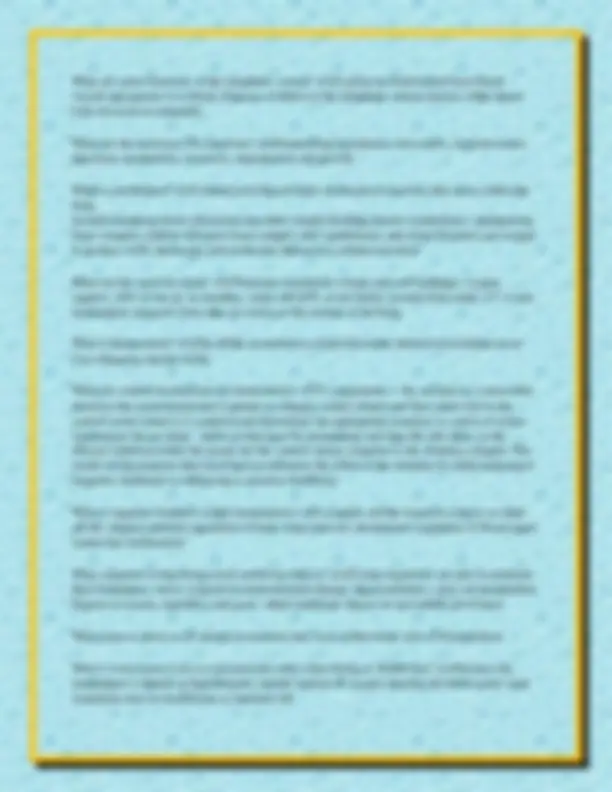
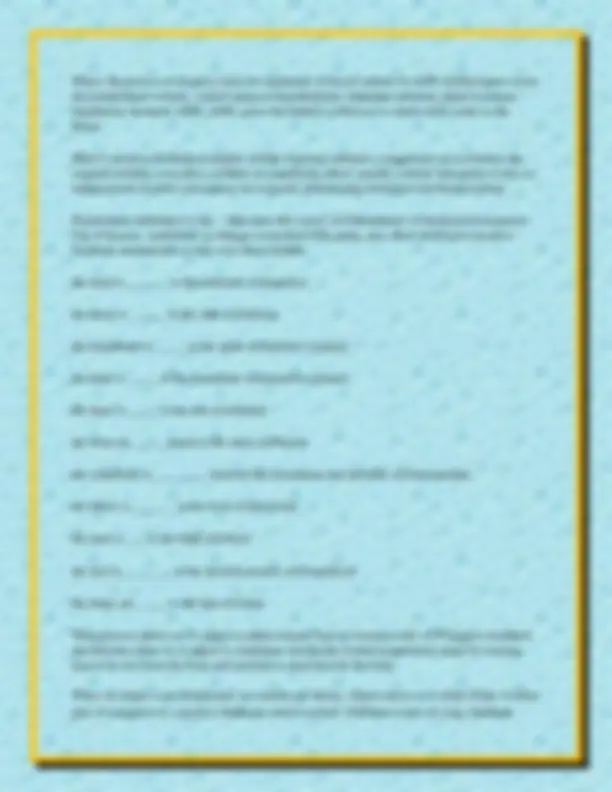
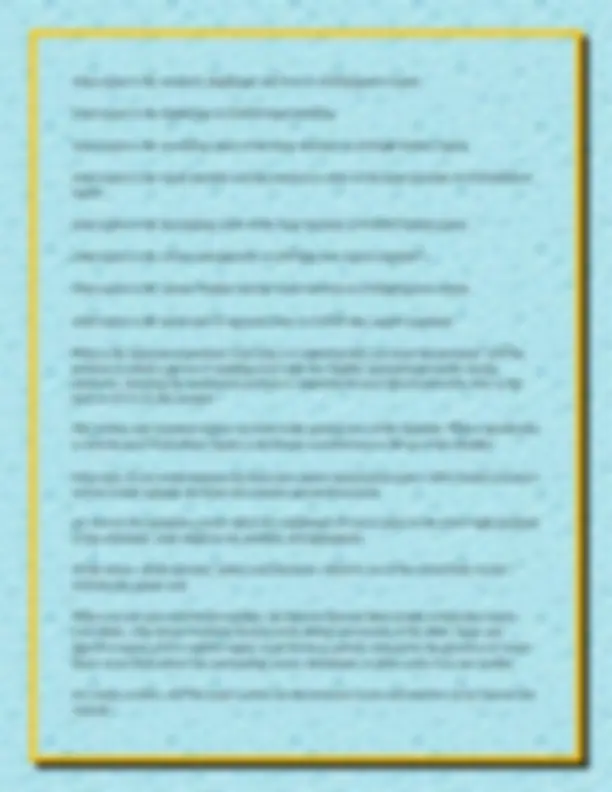
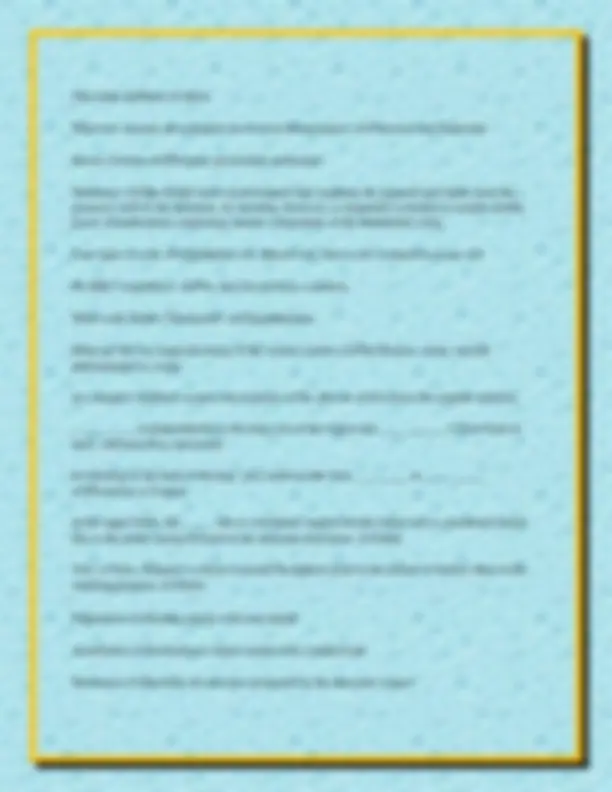



Study with the several resources on Docsity

Earn points by helping other students or get them with a premium plan


Prepare for your exams
Study with the several resources on Docsity

Earn points to download
Earn points by helping other students or get them with a premium plan
Community
Ask the community for help and clear up your study doubts
Discover the best universities in your country according to Docsity users
Free resources
Download our free guides on studying techniques, anxiety management strategies, and thesis advice from Docsity tutors
Human Anatomy and Physiology Chapter 1
Typology: Exercises
1 / 15

This page cannot be seen from the preview
Don't miss anything!










Human Anatomy and Physiology Chapter 1 Superior (cranial) ✔✔toward the head end or upper part of a structure or the body; above Inferior (caudal) ✔✔away from the head end or toward the lower part of a structure or the body; below Ventral (anterior) ✔✔toward or at the front of the body; in front of Dorsal (posterior) ✔✔Toward or at the back of the body; behind Medial ✔✔toward or at the midline of the body; on the inner side of Lateral ✔✔away from the midline of the body; on the outer side of Intermediate ✔✔between a more medial and a more lateral structure Proximal ✔✔closer to the origin of the body part or the point of attachment of a limb to the body trunk Distal ✔✔farther from the origin of a body part or the point of attachment of a limb to the body trunk Superficial ✔✔toward or at the body surface Deep (internal) ✔✔away from the body surface; more internal Anatomical Position ✔✔erect, feet forward, arms at side with palms facing forward, head facing forward, internationally know Directional Terms ✔✔allow us to explain where one body structure is in relation to another Axial ✔✔fundamental division of our body. Makes up the main axis of our body, includes the head, neck, and trunk. Appendicular ✔✔fundamental division of our body. relating to the limbs and their attachments to the axis. Regional Terms ✔✔used to designate specific areas within major body divisions
Abdominal ✔✔pertaining to the anterior body trunk region inferior to the ribs Acromial ✔✔pertaining to the point of the shoulder Antebrachial ✔✔pertaining to the forearm Antecubital ✔✔pertaining to the anterior surface of the elbow Axillary ✔✔pertaining to the armpit Brachial ✔✔pertaining to the arm Buccal ✔✔pertaining to the cheek Carpal ✔✔Pertaining to the wrist Cephalic ✔✔pertaining to the head Cervical ✔✔pertaining to the neck region Coxal ✔✔pertaining to the hip Crural ✔✔pertaining to the leg Digital ✔✔pertaining to the fingers or toes Femoral ✔✔pertaining to the thigh Fibular (peroneal) ✔✔pertaining to the side of the leg Frontal ✔✔pertaining to the forehead Hallux ✔✔pertaining to the great toe Inguinal ✔✔pertaining to the groin Mammary ✔✔pertaining to the breast Manus ✔✔pertaining to the hand
Otic ✔✔pertaining to the ear Perineal ✔✔pertaining to the region between the anus and external genitalia Plantar ✔✔pertaining to the sole of the foot Popliteal ✔✔pertaining to the back of the knee Sacral ✔✔pertaining to the region between the hips (overlying the sacrum) Scapular ✔✔pertaining to the scapula or shoulder blade area Sural ✔✔pertaining to the calf or posterior surface of the leg Vertebral ✔✔pertaining to the area of the spinal column Anterior/Ventral Body ✔✔ Posterior/Dorsal Body ✔✔ Sagittal ✔✔a vertical plane that divides the body into right and left parts Median Plane (midsagittal plane) ✔✔sagittal plane that lies exactly in the midline Parasagittal Planes ✔✔all other sagittal planes offset from the midline Frontal Planes (Coronal Plane) ✔✔like sagittal plane lie vertically, divide body into anterior and posterior parts Transverse/Horizontal Plane ✔✔runs horizontally from right to left, dividing the body into superior and inferior parts. (Transverse is perpendicular to long axis of an organ, horizontal is from front to back) Oblique Sections ✔✔cuts made diagonally between the horizontal and the vertical planes Dorsal Body Cavity ✔✔protects the fragile nervous system organs, has 2 subdivisions Cranial Cavity ✔✔in the skull, encases the brain
Vertebral Cavity (Spinal Cavity) ✔✔runs within the bony vertebral column, encloses the delicate spinal cord Ventral Body Cavity ✔✔the more anterior and larger of the closed body cavities, has 2 major subdivisions, houses internal organs called Viscera Thoracic Cavity ✔✔surrounded by the ribs and muscles of the chest Pleural Cavities ✔✔lateral subdivision of Thoracic Cavity, enveloping a lung, and the Medial Mediastinum Medial Mediastinum ✔✔contains the pericardial cavity Pericardial Cavity ✔✔encloses the heart and also surrounds the the remaining thoracic organs (esophagus, trachea, and others) Abdominopelvic Cavity ✔✔seperated from thoracic cavity by the diaphram, a dome shaped muscle important in breathing. Has abdominal and pelvic cavities Abdominal Cavity ✔✔Contains stomach, intestines, spleen, and liver, and other organs Pelvic Cavity ✔✔Contains urinary bladder, reproductive organs, and rectum Serosa (Serous Membrane) ✔✔the walls of the ventral body cavity and the outer surfaces of the organs it contains are covered by this thin double layered membrane Parietal Serosa ✔✔lines internal body walls Visceral Serosa ✔✔covers the internal organs Abdominopelvic Quadrants ✔✔Divisions used primarily by medical personnel Abdominopelvic Regions ✔✔Nine divisions used primarily by anatomists Umbilical region ✔✔The centermost region, which includes the umbilicus Epigastric Region ✔✔LOcater superior to the umbilical region Right and Left Iliac or Inguinal Regions ✔✔located lateral to hypogastric regions, superior part of the hip bone
What are 2 subdivisions of study for microscopic anatomy? ✔✔cytology (cells) and histology (tissues) What is developmental anatomy? ✔✔Tracing structural changes that occur in the body throughout the life span -- Embryology is a subdivision of developmental anatomy that concerns developmental changes occurring before birth What are some subdivisions of physiology? ✔✔renal physiology (operation of kidney), neurophysiology (nervous system), and cardiovascular physiology (operation of the heart and blood vessels) What is the principle of complementarity? ✔✔anatomy and physiology are inseparable, the function always refects structure and what a structure can do depends on its specific form. In what way does physiology depend of anatomy? ✔✔the operation or function of a structure is dictated by its anatomy Would you be studying anatomy or physiology if you investigated how muscles shorten? If you explored the location of the lungs in the body? ✔✔Muscle shortening is a topic of physiology. The body location of the lungs is an anatomy topic. What are the levels of structural organization? ✔✔chemical (atoms and molecules), cellular, tissue, organ, organ system and organismal level What does the digestive system do? ✔✔takes in nutrients, breaks them down into simple molecules that can be absorbed into the blood, and eliminates unabsorbed matter (feces) What does the respiratory system do? ✔✔takes in oxygen and eliminates carbon dioxide What does the urinary system do? ✔✔eliminates nitrogenous wastes and excess ions What does the cardiovascular system do? ✔✔via the blood, distributes oxygen and nutrients to all body cells and delivers wastes and carbon dioxide to deposal organs What does the integumentary system do? ✔✔Skin, hair and nails protect the body as a whole from the external environment - drying out, bacteria, heat, sunlight, chemicals all ____ depend on organ systems to meet their survival needs ✔✔cells _____ ____ work cooperatively to perform necessary life functions ✔✔organ systems
Integumentary system ✔✔Forms the external body covering and protects deeper tissues from injury - made up of hair, nails and skin Skeletal System ✔✔Protects and supports body organs and provides a framework the muscles use to support movement. Made up of bones and joints Muscular system ✔✔Allows manipulation of the environment, locomotion, and facial expression. Made up of skeletal muscles Nervous system ✔✔The fast acting control system of the body; it responds to internal and external changes by activating appropriate muscles muscles and glands. Made up of the the brain, nerves and spinal cord Endocrine system ✔✔Glands secrete hormones that regulate processes such as growth, reproduction, and nutrient use (metabolism) by body cells. Mad up of pineal, pituitary, thyroid and adrenal glands, thymus, pancreas, ovaries and testis Cardiovascular system ✔✔Blood vessels transport blood, which carries oxygen, carbon dioxide, nutrients, wastes, etc. The heart pumps blood. Made up of blood vessels and heart Lymphatic system/ immunity ✔✔Picks up fluid leaked from blood vessels and returns it to blood, disposes of debris in lymphatic system, houses while blood cells involved in immunity. Immune system attacks foreign substances in the body. Mad up of red bone marrow, thymus, lymphatic vessels, thoracic duct, spleen, and lymph nodes Respiratory system ✔✔Keeps blood constantly supplied with oxygen and removes carbon dioxide. Made up of nasal cavity, pharynx, larynx, trachea, lungs and bronchus Digestive system ✔✔Breaks down food into absorbable units that enter the blood for distribution to body cells. Indigestible foodstuffs are eliminated as feces Made up of oral cavity, esophagus, liver, stomach, small intestine, large intestine, rectum , and anus Urinary system ✔✔Eliminates nitrogenous wastes from the body. Made up of kidneys, ureter, urinary bladder, and urethra Male and female reproductive systems ✔✔Production of offspring. For male: prostate gland, penis, testis, scrotum, ductus deferens. female: mammary glands, ovary, uterine tube, uterus, and vagina
What's the process of negative back for regulation of blood volume by ADH ✔✔Receptors sense decreased blood volume, control center in hypothalamus stimulates pituitary gland to release antidiuretic hormone ADH, ADH causes the kidneys (effectors) to return more water to the blood. What is positive feedback examples ✔✔the response enhances, exaggerates or accelerates the original stimulus (cascades); exhibits an amplifying effect; usually controls infrequent events ex: enhancement of labor contractions by oxytocin, platelet plug formation and blood clotting Homeostatic imbalance is the ...what does this cause? ✔✔disturbance of homeostasis increases risk of disease, contributes to changes associated with aging, may allow destructive positive feedback mechanisms to take over (heart failure) the head is _______ to the abdomen ✔✔superior the navel is ______ to the chin ✔✔inferior the breastbone is _____ to the spine ✔✔anterior (ventral) the heart is _____ to the breastbone ✔✔posterior (dorsal) the heart is _____ to the arm ✔✔medial the arms are _____ lateral to the chest ✔✔lateral the collarbone is _________ between the breastbone and shoulder ✔✔intermediate the elbow is _______ to the wrist ✔✔proximal the knee is ___ to the thigh ✔✔distal the skin is ________ to the skeletal muscles ✔✔superficial the lungs are _____ to the skin ✔✔deep What process allows us to adjust to either extreme heat or extreme cold? ✔✔Negative feedback mechanisms allow us to adjust to conditions outside the normal temperature range by causing heat to be lost from the body and retained or generated by the body. When we begin to get dehydrated, we usually get thirsty, which causes us to drink fluids. Is thirst part of a negative or a positive feedback control system? ✔✔thirst is part of a neg. feedback
control system because it prods us to drink which ends the thirst stimulus and returns body fluid volume to the normal range Why is the formation of platelet plug called positive feedback? What event ends it? ✔✔This is a pos. feedback mechanism because it enhances the change set into motion by the stimulus. The response ends when the platelet plug has plugged the hole in the blood vessel. The two fundamental divisions of our body ✔✔Axial part - head, neck and trunk. Appendicular part- appendages or limbs Regional terms are used to ...... ✔✔designate specific areas within major body divisions The most frequent planes ✔✔Sagittal, Frontal, Transverse Sagittal plane ✔✔vertical plane- divides the body into right and left parts Midsagittal plane ✔✔median for the sagittal plane Parasagittal plane ✔✔offset from the midline or midsagittal plane Frontal plane ✔✔vertically divide the body into ventral and dorsal parts transverse or horizontal plane ✔✔horizontal from right to lfet dividint eh body into superior and inferior parts oblique sections ✔✔are cuts made diagonally between the horizontal and the verical planes What cavity is the brain in? ✔✔cranial cavity what cavity contains the spinal cord ✔✔vertebral cavity what cavity contains the heart and lungs ✔✔thoracic cavity what is between the thoracic cavity and the abdominal cavity ✔✔diaphragm what cavity contains the digestive viscera ✔✔Abdominal cavity what cavity contains the urinary bladder, reproductive organs and rectum ✔✔pelvic cavity
what region is the stomach, diaphragm and liver in ✔✔Epigastric region what region is the diaphragm in ✔✔left hypochondriac what region is the ascending colon of the large intestine in ✔✔right lumbar region what region is the small intestine and the transverse colon of the large intestine in ✔✔umbilical region what region is the descending colon of the large intestine in ✔✔left lumbar region what region is the cecum and appendix in ✔✔right iliac region (inguinal ) what region is the urinary bladder and the small intestine in ✔✔hypogastric region what region is the initial part of sigmoid colon in ✔✔left iliac region (inguinal) What is the anatomical position? And why is it important that you learn this position? ✔✔The position in which a person is standing erect with feet slightly separated and palms facing anteriorly. knowing the anatomical position is important because directional terms refer to the body as if it is in this position The axiliary and acromial regions are both in the general area of the shoulder. Where specifically is each located? ✔✔axillary region is the armpit. acromial area is the tip of the shoulder whay type of cut would separate the brain into aterior and posterior parts? ✔✔a frontal (coronal ) section would separate the brain into anterior and posterior parts joe went to the emergency room where he complained of severe pains in the lower right quadrant of this abdomen. what might be his problem ✔✔appendicitis Of the uterus, small intestine, spinal cord and heart, which is /are in the dorsal body cavity? ✔✔only the spinal cord When you rub your cold hands together, the friction between them results in heat that warms your hands. why doesnt warming friction result during movements of the heart, lungs and digestive organs ✔✔As mobile organs work fiction is greatly reduced by the presence of seours flued. seous fluid allows the surrounding serous membranes to glide easily over one another two major cavities, ✔✔The main cavities are the posterior cavity and anterior cavity (dorsal and ventral)
Olecranal ✔✔Back of elbow What tow systems are primarily involved in Homeostasis? ✔✔Nervous and Endocrine Serous Cavities ✔✔Pleaural, pericardial, peritoneal Mesentery ✔✔the double layer of peritoneum that suspends the jejunum and ileum from the posterior wall of the abdomen. Its meaning, however, is frequently extended to include double layers of peritoneum connecting various components of the abdominal cavity. Four types of cells: ✔✔Epithelial cell, Muscle cell, Nerve cell, Connective tissue cell Do RBC's reproduce? ✔✔No, they do not have a nucleus. What is the Body's Thermostat? ✔✔hypothalamus What are the two major divisions of the ventral cavities ✔✔the thoracic cavity, and the abdominopelvic cavity. In a negative feedback system, the response of the effector ✔✔reverses the original stimulus. ___________is perpendicular to the long axis of the region and ___________ is from front to back. ✔✔transverse, horizontal In referring to the back of the legs, you could use the term _________ or __________. ✔✔Posterior or Ventral In the upper limbs, the _____ side is considered medial and the radial side is considered lateral due to the palms facing forward in the anatomical position. ✔✔ulnar True or False. Superior is always towards the highest point in the animal or human when in the standing position. ✔✔False Palpatation ✔✔feeling organs with your hands Ausultation ✔✔Listening to organ sounds with a stethoscope Movement ✔✔Includes all activities promoted by the muscular system